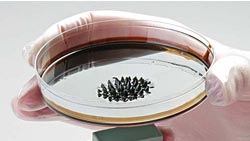![]()
Molecular Structure, Bonding, Orbital Hybridization
9.6 Ferrofluid
 Subjects: Molecular structure, magnetism, properties of liquids and solids, colloids
Subjects: Molecular structure, magnetism, properties of liquids and solids, colloids
Description:The properties of a ferrofluid containing nano-sized particles of a magnetic material are explored with a magnet.
Materials:
- 100 mL Bulk Ferrofluid in bottle
- Magnets
- Petri dish, flask, or other container
- Penny (optional)
- Transfer pipets
Procedure:
Note: Ferrofluid will stain. Use caution to prevent spills.
1. Pour a sample of ferrofluid into the container.
2. Bring the magnet close to the container and observe the spikes produced in the fluid.
3. Put the penny in the petri dish. Repeat step 2 and observe how the penny will “float” on top of the fluid spikes due to the increase of density when a magnetic field is applied.
4. In a walled container, use the magnet to pull the fluid up the sides of the container. When the magnetic field is removed, the fluid will flow back down the sides of the container.
Discussion (ref1):
Ferrofluids have the fluid properties of a liquid and the magnetic properties of a solid. Ferrofluids actually contain tiny particles (~10 nm diameter) of a magnetic solid suspended in a liquid medium.
Ferrofluids were originally discovered in the 1960s at the NASA Research Center, where scientists were investigating different possible methods of controlling liquids in space. Researchers have prepared ferrofluids containing small particles of ferromagnetic metals, such as cobalt and iron, as well as magnetic compounds, such as manganese zinc ferrite, ZnxMn1-xFe2O4. (0 < x < 1; this is a family of solid solutions). But by far, the most work has been conducted on ferrofluids containing small particles of magnetite, Fe3O4.
Ferrofluids can either be water-based or organic-based (particles suspended in oil, fluorocarbons, etc.) depending on their intended use. The ferrofluid used in the demonstrations is an organic-based ferrofluid.
The basis for magnetism can be explained at the atomic level. Electrons have both an electrical charge and a spin, it can be called a charge in motion. Any moving charge gives rise to a magnetic field. The spin of an electron can be oriented in one of two directions, either up or down. When electrons pair up in an energy level they will have opposite spins and their magnetic fields will cancel.
In some atoms there can be more electrons with spins in one direction than the other because they are not all paired up (Pauli Exclusion Principle). The result is that there is a net magnetic field for the atom. This is a paramagnetic material. When placed in a magnetic field the atoms in a paramagnetic material will tend to align their fields with the external one, i.e., the North Pole of each atom will align with the North Pole of the applied magnetic field. Paramagnetic substances are only weakly attracted by a magnet.
By comparison, some substances contain regions in which the atoms tend to line up in the same direction so that they reinforce one another. Such a region is called a domain. When a material contains domains such as this it is called a ferromagnetic material. When placed in a magnetic field the domains will tend to align their fields with the external one.
Safety:
Neodymium magnets are extremely strong and unexpectedly can attract other magnets or pieces of ferrous metal. Often this results in pinched fingers and flying chips from the magnets.
Safety glasses, rubber gloves, and protective clothing must be worn whenever using neodymium magnets and ferrofluid. When neodymium magnets collide with an object, they sometimes chip and ferrofluid will permanently stain surfaces such as tabletops, clothing, skin, or eyes.
Disposal:
None. The Ferrofluid can be reused.
References:
1. University of Wisconsin: Exploring the NanoWorld Website.
http://mrsec.wisc.edu/Edetc/background/ferrofluid/index.html
Adapted from Teaching General Chemistry: A Materials Science Companion by A. B. Ellis, M. J. Geselbracht, B. J. Johnson, G. C. Lisensky, and W. R. Robinson. Copyright © 1993, American Chemical Society, Washington, DC
2. Science Kit (photo)
http://sciencekit.com/scholar-ferrofluid-demonstration/p/IG0035634/


